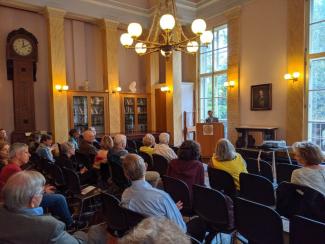Philadelphia and the World’s Water Crisis: Local Solutions to a Global Challenge

The Water Center at Penn (WCP) Senior Fellow and Director of the Penn Global China Program, Scott Moore, gave a talk about “Philadelphia and the World’s Water Crisis: Local Solution to a Global Challenge” at the Athenaeum of Philadelphia on Tuesday, October 29th. The event attracted over 30 people interested in learning more about the world’s water problems and how Philadelphia has contributed to finding solutions to these problems.
Moore’s recently published book, “Subnational Hydropolitics: Conflict, Cooperation, and Institution-Building in Shared River Basins”, examines how climate change and other pressures affect the likelihood of conflict over water within and between countries. In his talk, Moore described three main challenges that we have to overcome to resolve the water crises. Most countries around the world have been facing these challenges throughout history, however, these challenges have become more evident and problematic because of the devastating global impact of climate change.
The first challenge is the uneven distribution of fresh water on Earth. Not having enough fresh water available where it is needed is a problem affecting the growing human population on the planet. “About 70% of the earth is covered by water but only 2.5% is freshwater”.[1] As human population continues to grow, the demand for freshwater increases, largely due to the need for food and large-scale agriculture. Agriculture is the largest user of water on Earth, using 70% of the freshwater available.[2] Agriculture is also affected by the uneven distribution of and lack of accessibility to fresh water. As an example, many farmers in the Great Plains receive their water from an extensive network of infrastructure that connects these farms with bodies of freshwater located many miles away.
The second challenge is having fresh water at the right time, in other words, having fresh water available not only where but also when it is needed. As global temperature continues to rise, the water cycle has become more unpredictable leading to more severe weather. According to NASA, rising temperatures will continue to increase evaporation, which will lead to heavier rain and increase the risk of flooding in areas closer to coasts, rivers, and streams.[3] While flooding may increase in some areas, other areas will experience less rain and more droughts.
The third and biggest challenge, is water quality. Water quality issues grabbed national attention during the Flint, Michigan water crisis when about 9,000 children younger than six years old were exposed to lead.[4] Most recently, a similar lead related water quality problem closer to home in Newark, NJ made headlines. Climate change has also taken a toll on water quality. One reason is eutrophication that results in an increase in algal blooms. This in turn leads to low-oxygen in the water, which can kill fish and other living organisms and make the water undrinkable. Accessibility to clean water is a problem that does not only affect the US but also many other countries in the world. It is estimated that around 780 million people do not have access to clean water worldwide.[5]
But not all is negative in the conversation on water and climate change. During his talk, Moore listed three possible solutions to the different water challenges and described how Philadelphia has tackled these issues.
The first solution is to pay the fair value for water. Raising the price of water is very unpopular but in order to supply and manage clean water, a higher water price is inevitable. Like in many US cities, the cost of water is rising in Philadelphia. A typical water bill for a resident in Philadelphia in 2018 was $66.50. This includes water, sewer, stormwater, and service.[6] This cost can become problematic as according to the U.S Census Bureau, in 2018 24.5% of Philadelphians live below the poverty line.[7] So what can people do if they cannot afford to pay their water bills? The Philadelphia Water Department has created Customer Assistance Programs to help Philadelphians who are having problems paying their water bill. Programs like the one offered in Philadelphia could help tackle the problem of increasing the water prices while not neglecting inequality issues.
The second solution is green infrastructure. One way of improving water infrastructure is to combat water problems by “building with nature”. Building with nature uses natural elements like grass, soils, plants, and trees to create spaces that absorb excess water and clean it through natural filtration processes. Building with nature not only addresses extreme weather events such as flooding, it simultaneously protects the environment and creates green spaces that serve as recreational areas for communities. One example in Philadelphia is the Wissahickon Valley Park. It’s hard to imagine it now, but throughout the 18th and 19th century the Wissahickon Creek was surrounded by industrial mills that produced different goods. Luckily in the late 1800s, the Fairmount Park Commission purchased 1,800 acres of the Wissahickon Valley in order to protect the area. The park’s close proximity to the city provides Philadelphians with the opportunity to escape city life and reconnect with nature. Philadelphia has also created a 25-year plan to improve the health of creeks and rivers called Green City, Clean Waters (GCCW). The goal of GCCW is to reduce water pollution by using green infrastructure such as rain gardens to address storm water management needs in the city. [8]
Lastly, Moore explained that the third solution is cooperation between three major stakeholders: water users, government, and third parties. One example of this stakeholder cooperation is the Delaware River Basin Commission (DRBC). The DRBC was established in 1961 and was signed into law by president John F. Kennedy, along with the governors of Delaware, New Jersey, Pennsylvania, and New York.[9] The commission was formed as a result of water resource challenges that were affecting the region. It remains active and effective today in ensuring that water resources are protected and shared equitably.
Throughout his talk, Moore stressed the importance of water for humans to survive. He described how when you look for signs of life outside our planet, you look for evidence of water, showing that water is the source of our existence.
[1] https://www.nationalgeographic.com/environment/freshwater/freshwater-crisis/
[2] https://www.nationalgeographic.com/environment/freshwater/food/
[3] https://pmm.nasa.gov/resources/faq/how-does-climate-change-affect-precipitation
[4] https://www.washingtonpost.com/education/2019/07/03/how-flint-water-crisis-set-back-thousands-students/
[5] https://www.cdc.gov/healthywater/global/wash_statistics.html
[6] https://www.phila.gov/water/PDF/RatesFY19-21_FactSheet-p2_What-does-a-typical-monthly-bill-pay-for.pdf
[7] https://www.phila.gov/2019-09-26-progress-in-fight-against-poverty-lower-poverty-rate-higher-income/
[8] https://www.phila.gov/water/sustainability/greencitycleanwaters/Pages/default.aspx

